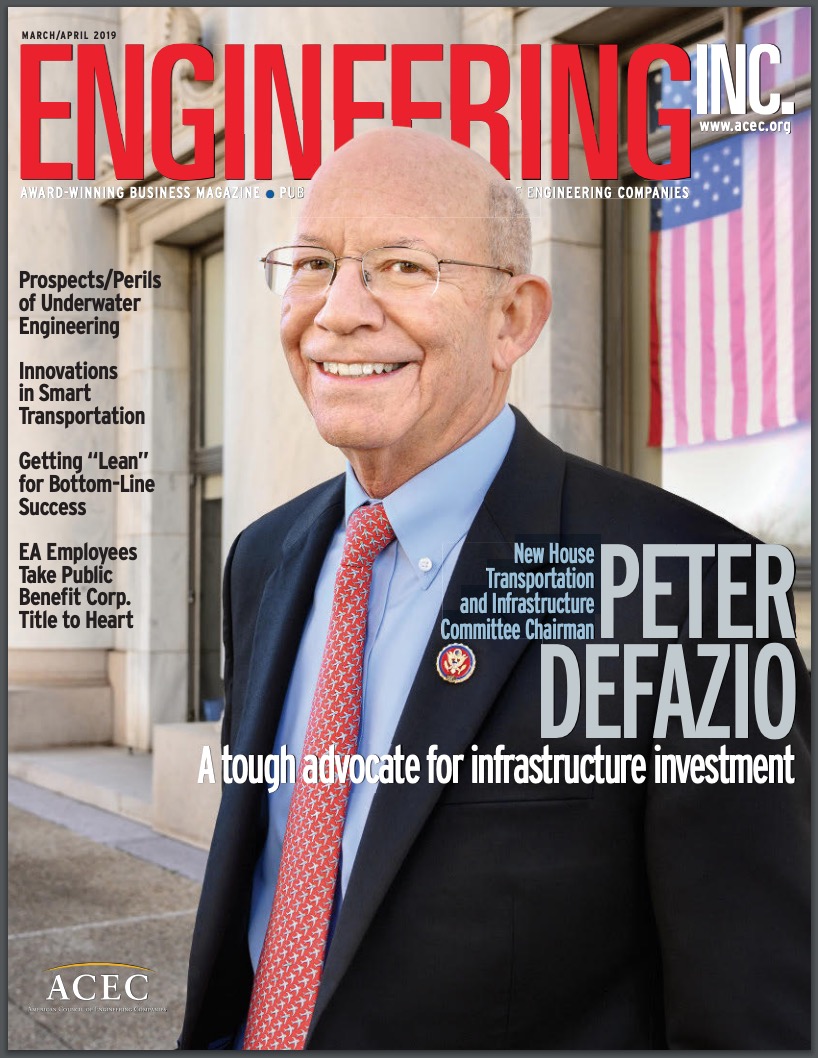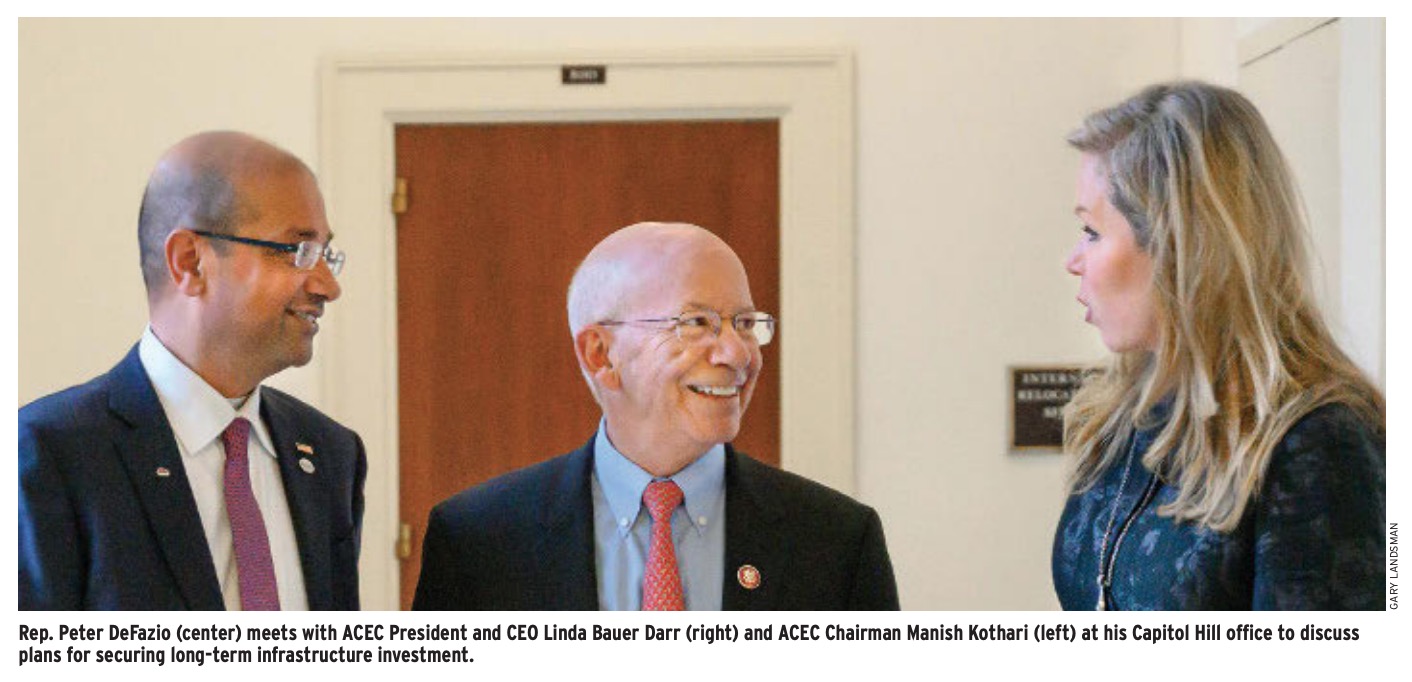AMERICAN COUNCIL OF ENGINEERING COMPANIES (ACEC)
Time to Bite the Bullet
 Rep. Peter DeFazio, D-Ore., is the new chairman of the powerful House Transportation and Infrastructure Committee, which has jurisdiction over highway and transit programs, water resources, the U.S. Army Corps of Engineers, railroads, aviation, the U.S. Coast Guard and the Federal Emergency Management Agency. DeFazio, who was first elected to Congress in 1986, is now the longest-serving House member in Oregon’s history.
Rep. Peter DeFazio, D-Ore., is the new chairman of the powerful House Transportation and Infrastructure Committee, which has jurisdiction over highway and transit programs, water resources, the U.S. Army Corps of Engineers, railroads, aviation, the U.S. Coast Guard and the Federal Emergency Management Agency. DeFazio, who was first elected to Congress in 1986, is now the longest-serving House member in Oregon’s history.
DeFazio has been a member of the House Transportation and Infrastructure Committee since he entered Congress and has served as chairman or ranking member of four of the six subcommittees: Aviation, Coast Guard and Maritime Transportation, Highways and Transit, and Water Resources and Environment. He has taken a lead role on several multibillion-dollar surface transportation and Federal Aviation Administration reauthorization bills and worked to strengthen Buy America standards.
In an exclusive interview with ACEC’s Engineering Inc., DeFazio discusses his plan to secure robust infrastructure investment that translates into significant job creation, increased safety, economic efficiency and strategic growth.
Rep. Peter DeFazio, D-ORE., Discusses Ideas for Long-Term, Sustainable Infrastructure Investment
ACEC: Everyone is talking about infrastructure investment as an area for bipartisan cooperation in 2019. What are the prospects, and how broad in scope do you expect the package to be?
Rep. Peter DeFazio: Congress must ensure that investments made today will meet the needs of the next generation of Americans. We cannot just maintain what we have; we also need to modernize how we plan and build transportation projects. We need stronger, more resilient transportation facilities that will have a longer life span and withstand the changing climate. We must identify ways to ensure that our states and local partners can deliver projects quickly and efficiently—without undercutting safety, critical environmental protections or worker rights.
In the 116th Congress, we inherit a decade of underinvestment in surface transportation. We simply have not kept up a level of investment to allow our transportation systems to work for future generations, kept our growing population moving and our economy competitive. This problem has been exacerbated by the fact the federal funding source for highways, bridges, transit, safety, bicycle and pedestrian infrastructure, congestion mitigation and transportation planning—the Highway Trust Fund—has been in the red since 2008. Previous Congresses have avoided addressing this revenue shortfall, electing instead to pass funding transfers and other short-term fixes. At the federal level, we cannot support states and cities—and move America forward—without identifying additional revenues.
ACEC: Will you be able to convince congressional leaders and the administration to support long-term, sustainable revenue solutions for the Highway Trust Fund and other infrastructure programs?
DeFazio: We have to bite the bullet and pay for the long-term, sustainable revenue we need—it is one of the most important things we can do in an infrastructure proposal. That means providing real funding, and not borrowing, implementing gimmicks, leveraging or devolution or selling off assets. We must go beyond the status quo in terms of spending, if we want to both maintain the assets we have and modernize our infrastructure.
I am open to any ideas on that front, but I have proposed three solutions that provide the revenues needed for real investment.
First, the A Penny for Progress Act provides approximately $500 billion for infrastructure investment to improve the conditions of our nation’s highways, bridges and public transit systems; address state-of-good-repair backlog; and meet estimated future highway and transit needs. We can achieve this level of investment by indexing the gas and diesel tax. We can provide a boost in investment by bonding off the indexation revenues and bringing those revenues forward. We are also exploring ways to take into account growing electric vehicle use in the future.
Second, the Unlocking the Harbor Maintenance Trust Fund Act amends current budgetary controls to allow the Army Corps of Engineers to spend the funds collected in the Highway Trust Fund each year, thereby providing more than $18 billion for our nation’s coastal and inland harbors over the next decade without raising taxes or increasing the deficit.
Finally, the Rebuilding America’s Airport Infrastructure Act will generate billions of dollars each year to help our airports rebuild and rehabilitate aging terminals, runways and taxiways, and keep pace with increasing demand in the 21st century— without raising taxes—by raising or eliminating the cap on the passenger facility charge.
ACEC: Engineering firms are being tasked to design structures and systems to withstand and adapt to increasing extreme weather events, rising sea levels, and other natural and manmade disasters. What federal policies, in addition to the changes made in the Disaster Recovery and Reform Act of 2018, are needed in the infrastructure arena to help address future risk mitigation?
DeFazio: What is really important is not only designing, engineering and building for resilience—it is building to an insurable standard. If an infrastructure project is uninsurable due to a known risk, we should really be asking if there is a cost-effective way to mitigate that risk; otherwise the federal government is eventually going to be on the hook again to pay for any future damages.
Some will argue that climate change is not real until they are drowning from sea level rise, but it is undeniable to argue that our nation has witnessed and experienced significant environmental changes over the last few decades. From a federal funding perspective, Congress cannot continue to pay to reconstruct uninsurable infrastructure—that is just wasting taxpayer dollars.
In the 2018 National Defense Authorization Act, Congress and the Department of Defense (DoD) agreed to build all critical infrastructure on DoD properties worldwide to 3 feet above the base flood elevation and noncritical infrastructure to 2 feet above the base flood elevation. That is a great first step, but it does not apply to non-DoD federally funded infrastructure.
We know that mitigation in the built environment—whether to lessen the impacts of flood, seismic, wind, terror, etc. events—is a massive cost savings to the public in the long run. We need to constantly be looking for ways to incentivize more mitigation to strengthen resilience in the built environment.
ACEC: Technological advancements are dramatically changing the face of transportation, from smart cities to autonomous and connected vehicles to unmanned aircraft. How can federal policies keep up with this dynamic and disruptive environment?
DeFazio: Cities and states are leading the way in innovative new approaches to moving people such as transportation network companies, scooters, bike share, microtransit (first mile/last mile connections) and autonomous vehicles. At the federal level, we need to support policies that allow innovative mobility solutions to thrive. At the same time, Congress must consider and address negative impacts from these new solutions such as increased congestion, emerging safety challenges and potential job losses.
We will also need adaptable infrastructure in the future that will overcome the crippling congestion problems we face. We should be directing investment to the most efficient, cost-effective and environmentally sustainable ways to move people.
ACEC: Your predecessor on the House Transportation and Infrastructure Committee re-established a practice of doing a Water Resources Development Act (WRDA) every two years. Do you plan to continue that practice, and will WRDA continue to feature water infrastructure such as the Clean Water and Drinking Water State Revolving Fund programs and Water Infrastructure Finance and Innovation Act expansion, in addition to the Corps of Engineers programs?
DeFazio: I was pleased to work with former Chairman Bill Shuster, R-Pa., in enacting a new, bipartisan water resources development bill every two years over the past three Congresses, and fully expect to continue that tradition in the 116th Congress. Regular enactment of a water resources bill provides predictability to local sponsors in ensuring that vital flood control, navigation and environmental projects and studies are authorized when ready and allows the committee to conduct regular oversight of the Corps of Engineers’ implementation of these projects.
It is also my hope that this year, Congress can finally reauthorize the Clean Water State Revolving Fund program—the primary source of federal funds for our nation’s wastewater infrastructure. This popular program, which routinely gets bipartisan support, has not been reauthorized since 1987. I will work to ensure that its reauthorization will move with Congress’ efforts to enact a comprehensive infrastructure package later this year.
ACEC: Congress enacted an array of project delivery permitting reforms in Moving Ahead for Progress in the 21st Century Act (MAP-21), the Fixing America’s Surface Transportation Act (FAST), WRDA and other infrastructure bills. What is the status of implementation of those reforms, and what is your perspective on what additional legislative changes might be necessary for facilitating efficient project delivery while ensuring adequate environmental and regulatory protections?
DeFazio: After years of delays, the Department of Transportation (DOT) has finally completed work on the majority of the 42 actions it was required to take to implement the streamlining provisions that Congress approved as part of MAP-21 and the FAST Act. However, the DOT has yet to assess the effectiveness of these streamlining provisions.
According to the Congressional Research Service, the overwhelming majority of federally assisted highway projects—90 percent—proceed under a categorical exclusion. Only 4 percent of projects require the preparation of an Environmental Impact Statement, the most detailed review document. A recent report, commissioned by the Department of the Treasury, identified 40 economically significant transportation and water projects whose completion has been slowed or is in jeopardy. The report found that “a lack of public funding is by far the most common factor hindering the completion of transportation and water infrastructure projects.” Further, the report found that delays resulting from environmental review and permitting were identified as a challenge to completing less than a quarter of the projects.
We cannot streamline our way out of our funding shortfall. I am open to additional ways to ensure projects are delivered as quickly and efficiently as possible, provided that we do not roll back environmental protections.
Download full article (PDF): A Tough Advocate for Infrastructure Investment
Download full March/April 2019 issue of Engineering, Inc.
 About the American Council of Engineering Companies
About the American Council of Engineering Companies
www.acec.org
The American Council of Engineering Companies (ACEC) is the voice of America’s engineering industry. Council members – numbering more than 5,000 firms representing more than 500,000 employees throughout the country – are engaged in a wide range of engineering works that propel the nation’s economy, and enhance and safeguard America’s quality of life. These works allow Americans to drink clean water, enjoy a healthy life, take advantage of new technologies, and travel safely and efficiently. The Council’s mission is to contribute to America’s prosperity and welfare by advancing the business interests of member firms.
Tags: Chairman DeFazio, House Committee on Transportation and Infrastructure, Peter DeFazio







 RSS Feed
RSS Feed